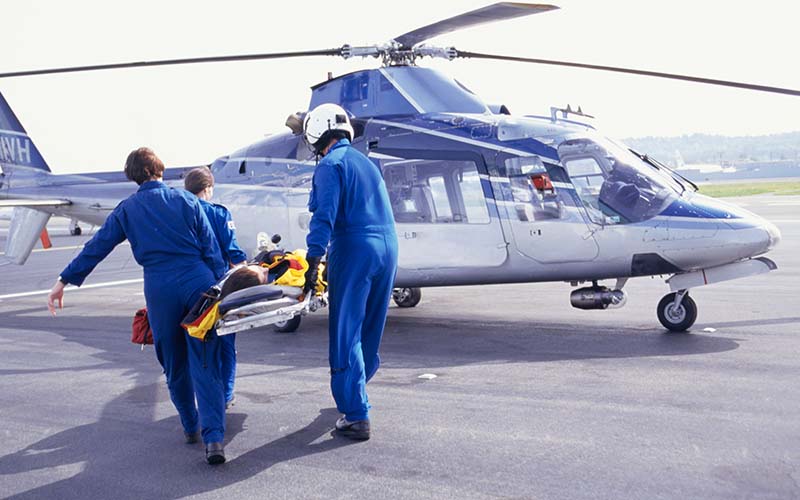A quest for knowledge: air medical evacuation high-level containment transport

Jocelyn Herstein, Claire Figi and Shawn Gibbs call for a global discussion and consensus regarding air medical evacuation high-level containment transport
Air medical evacuation (AE) high-level containment transport (AE-HLCT) is the process of transportation of patients with confirmed or suspected high-consequence infectious diseases (HCID), that necessitate a high-level isolation environment within fixed-wing or rotary-wing aircraft.
HCIDs are defined by the European Network for Highly Infectious Diseases as ‘an infection that is easily transmissible from person to person; life-threatening; presents a serious hazard in the healthcare setting and the community; and requires specific control measures (e.g. high-level isolation)’. Despite a drastic increase in the need for, and number of, AE-HLCT missions in the past decade (e.g. early months of Covid-19 and Ebola virus disease [EVD]), the field remains understudied, with a comparatively small number of peer-reviewed publications, mostly consisting of case studies. While helpful, these are just the tip of evaluation needs for AE-HLCT. In the context of HCIDs, AE-HLCT is focused on both individuals with a high-risk exposure or a confirmed HCID case.
AE and AE-HLCT are high-risk environments compared with conventional hospital settings, requiring specially trained transport teams and an additional enhanced level of guidance. However, AE- and AE-HLCT-specific guidelines vary between countries and companies. Our team has published a commentary, highlighting the need for a global discussion and consensus regarding AE-HLCT standardization and guidelines, as well as two literature reviews (in 2019 and 2023) that compiled the relatively sparse AE-HLCT literature – with the most recent highlighting the impact of the pandemic on advancing the field of AE-HLCT. These standards are severely lacking, and previous experiences or lessons learned are largely unavailable in published documents.
Distinctive features
AE-HLCT transports require specialized management and considerations for pre-flight, in-flight and post-flight. Configuration, or layout, of the space is particularly important when moving respiratory pathogens, due to airflow within the cabin and cockpit. Portable isolation units (PIUs) can be utilized, if available, to isolate the patient; however, many models limit the level of care that can be then provided to the patient.
AE-HLCT transports require specialized management and considerations for pre-flight, in-flight and post-flight.
As such, teams must consider patient acuity, comfort, and potential for deterioration during transport. PIUs are typically used for single patient movement over relatively short transports, whereas multi-patient systems can isolate numerous patients simultaneously; some even have capabilities to provide anterooms and rest areas for care providers. Regardless of the transport modality, a patient with an HCID can deteriorate quickly, thus changing the risk profile, treatment needs and environment.
Each transport team must be highly prepared and trained in isolation care in an aircraft setting, with coordination, collaboration and approval decisions carefully discussed and reviewed between stakeholders. Just-in-time training (JITT) can quickly refresh and ready the team for missions. AE-HLCT often requires an altered standard of care during transport, weighing the potential level of risk to the care and transport team, against the benefit to the patient when determining allowable medical procedures or interventions – personal protective equipment (PPE) must be identified and stocked. Procedures that may occur during transport (such as aerosol-generating procedures) will impact the level of PPE required, the use of PIUs, and further equipment needed. Waste handling and disposal processes require special considerations; however, standards are lacking, and regulations/laws vary widely, both within the US and between countries. If the transport is cross-border or cross-jurisdiction, regulations must be considered and followed.

Post-pandemic advancements
In the past several years, there have been many advancements in AE-HLCT, including isolation systems that facilitate the provision of higher levels in-flight care. These include both single-patient PIUs (e.g. EpiShuttle), and larger containerized systems capable of transporting and providing direct care to multiple patients, such as the Containerized Biocontainment Care System (CBCS). Additionally, Covid-19 forced the consideration of mass or collective AE-HLCT that had not previously been operationalized. AE for repatriation of large numbers of exposed, potentially positive asymptomatic individuals was needed in ways not previously executed. The AE-HLCT of passengers of the Diamond Princess cruise ship is likely the earliest example of such a transport that moved dozens of those individuals. This has created and field-tested a capability not previously demonstrated in AE-HLCT.
The novelty of Covid-19 in the first weeks of the pandemic led to the use of high caution when transporting suspected or confirmed cases. Most transport teams with previous AE-HLCT experience mimicked AE-HLCT protocols from patients with EVD, which was reasonable at the time given the unknowns. However, the limited global AE-HLCT capacity was quickly exceeded in the early months of Covid-19, leading to many teams conducting these types of transports without previous AE-HLCT experience.
Due to the need for AE of individuals with suspected or confirmed Covid-19, as well as for routine AE flights of patients with unknown Covid-19 status, the field of AE-HLCT was pushed forward. The novelty and widespread nature of Covid-19 forced helicopter emergency medical services (HEMS) to consider that every patient they were asked to transport could also be a potential source of transmission.
The novelty and widespread nature of Covid-19 forced helicopter emergency medical services to consider that every patient they were asked to transport could also be a potential source of transmission
As such, general HEMS transport procedures were re-evaluated and provided a greater emphasis of the usage of PPE to prevent transmission of a respiratory disease. This served to increase the literature and procedures available for AE-HLCT that considered and actively planned for a HEMS-related transport; previously, AE-HLCT had been dominated by fixed-wing transport with minimal HEMS experience. As a result, utilization of HEMS for AE-HLCT is likely to be more common in future HCID outbreaks to bridge the gap of shorter distance transports, that had previously relied on hours of ground transport.